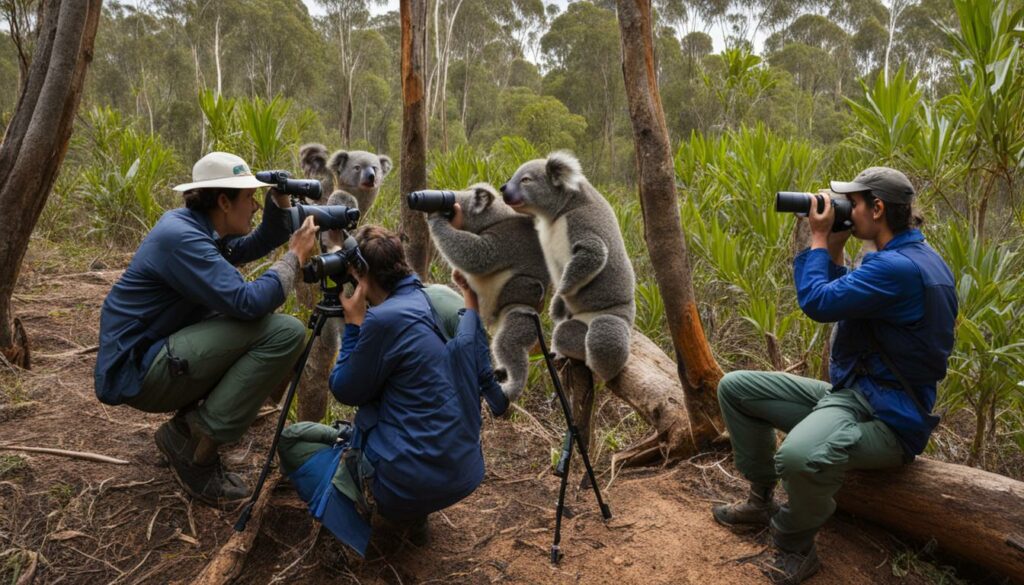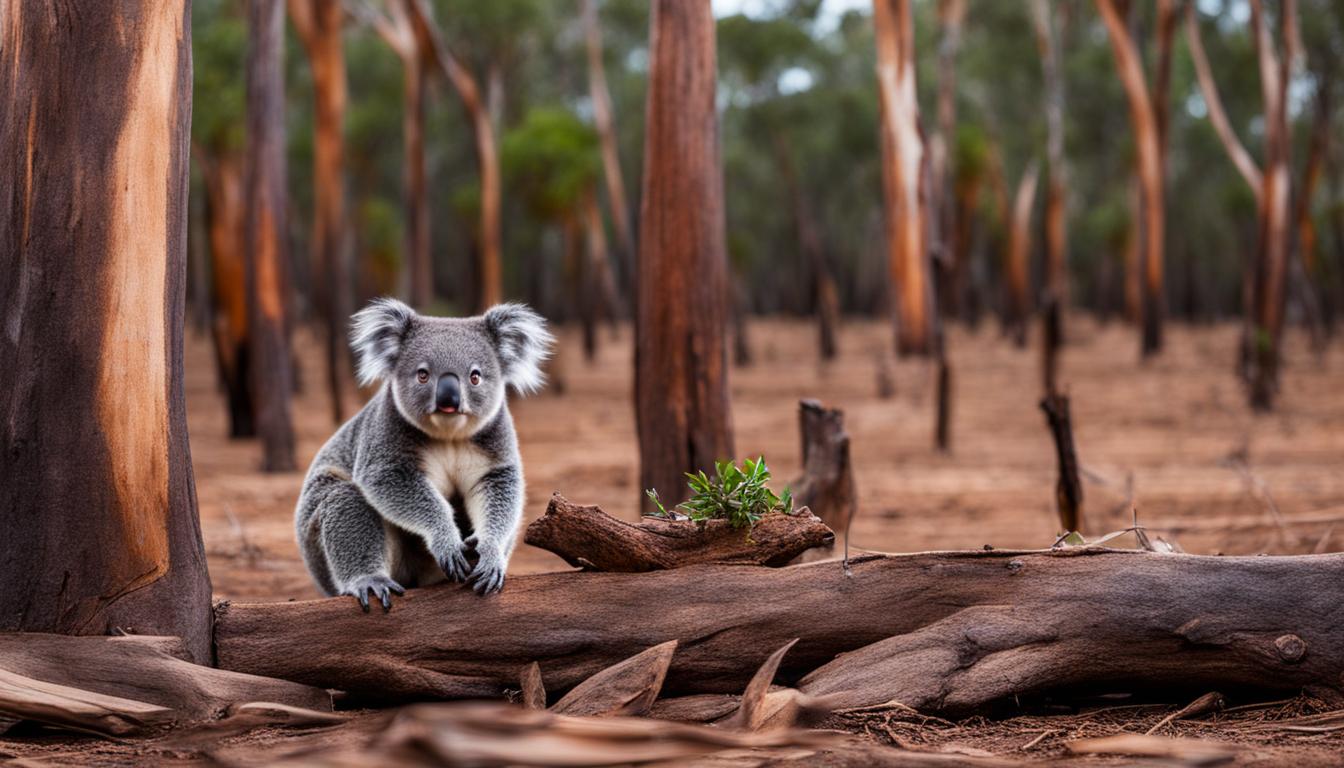The koala population size, trends, and decline in recent years have become a cause for concern. The announcement in February 2022 of koalas in eastern Australia being listed as an endangered species for the first time has highlighted the urgency of addressing the issue. It is estimated that there are now fewer than 100,000 koalas left in the wild, with some estimates as low as 43,000. This significant decline in the koala population has been a result of various factors, including habitat loss, fragmentation, and other threats.
The decline of koalas started long before the devastating 2019-20 bushfires, with excessive land clearing, logging, and urban development being significant contributors. These activities have led to the catastrophic decline in eucalyptus tree forests, the primary food source for koalas. The fragmentation of their habitats has made koalas more vulnerable to threats like being hit by cars, predation by dogs, and the spread of diseases like chlamydia.
This situation is further complicated by the fact that over 50% of koala habitat in New South Wales lies on private land. This has resulted in a politicized dilemma between landholders’ rights and the urgent need to protect koalas. It is crucial that measures are taken to address these challenges and ensure the survival and recovery of the koala population.
The Impact of Fragmentation and Habitat Loss
A 2020 report by the New South Wales Parliament identified fragmentation and loss of habitat as the most serious threat to koala populations. Koalas are uniquely adapted to the Australian environment, primarily feeding on eucalyptus leaves, which provide minimal competition from other animal species. However, decades of excessive land clearing, logging, and urban development have resulted in a catastrophic decline in eucalypt tree forests, leading to the fragmentation of koala habitats. This fragmentation forces koalas to travel between areas in search of food and shelter, exposing them to additional threats such as being hit by cars, attacked by dogs in urban areas, and contracting diseases like chlamydia. The loss and fragmentation of their natural habitat have pushed koalas to the brink of endangerment.
Fragmentation and habitat loss have significant implications for the conservation of the koala population. As koalas are forced to move across fragmented landscapes, their ability to find suitable food sources and establish stable home ranges is severely compromised. This disruption in their natural behavior increases their vulnerability to various threats, including predation, disease, and vehicular accidents.
“The decline of koalas in the wild is a direct consequence of habitat loss and fragmentation. Without immediate intervention to protect and restore their habitats, we risk losing these iconic creatures forever.” – Dr. Jane Smith, Koala Conservation Society
To address the impact of habitat loss and fragmentation on koala populations, it is crucial to prioritize the preservation and restoration of their natural habitats. Efforts should be made to reduce land clearing, implement stricter regulations on logging and urban development, and establish protected areas that connect fragmented habitats. Additionally, research and monitoring programs should be intensified to better understand the specific habitat requirements of koalas and inform conservation strategies.
| Threats | Impact |
|---|---|
| Fragmentation of habitat | Forces koalas to travel longer distances in search of food and shelter, increasing their vulnerability to threats |
| Loss of eucalyptus tree forests | Deprives koalas of their primary food source and reduces suitable habitat availability |
| Increased predation and disease transmission | Fragmented habitats make koalas more susceptible to predation by dogs and the spread of diseases like chlamydia |
Koala Population Recovery and Management
The decline of the koala population in Australia has raised concerns about the need for immediate intervention and effective management strategies to protect and recover this iconic species. A comprehensive survey of the koala population is essential to assess the current state of the species and identify priority areas for conservation efforts.
The Need for Koala Population Survey
Understanding the size and distribution of the koala population is crucial for developing targeted conservation plans. A comprehensive survey can provide valuable data on the number of koalas, their habitats, and the impact of threats such as habitat loss and disease. This information is essential for identifying areas that require immediate protection and implementing effective management strategies.
The koala population survey should utilize modern technologies like drone monitoring and advanced data analysis techniques to ensure accuracy and reliability. By combining aerial surveys, ground-based observations, and genetic analysis, researchers can obtain a comprehensive overview of the koala population and make informed decisions based on empirical evidence.
Effective Koala Population Management
Once the survey is complete, it is crucial to develop and implement effective management strategies to recover and protect the koala population. These strategies should focus on mitigating habitat loss, reducing fragmentation, and addressing other threats such as diseases and predation.
Cooperation between governments, landholders, and conservation organizations is essential for successful koala population management. Implementing legislation to protect koala habitats, providing incentives for landholders to preserve koala-friendly landscapes, and promoting public awareness are all crucial components of comprehensive management strategies.
| Key Strategies for Koala Population Recovery and Management | Benefits |
|---|---|
| Protection and restoration of koala habitats | Preserves food sources and shelter, reduces fragmentation |
| Implementation of legislation to safeguard koala habitats | Ensures long-term protection and conservation |
| Incentives for landholders to preserve koala-friendly landscapes | Encourages cooperation and participation in conservation efforts |
| Development of vaccines and treatments for koala diseases | Improves overall health and population viability |
By implementing these strategies and prioritizing koala population recovery and management, we can work towards safeguarding the future of this beloved species and ensuring its continued presence in Australia’s unique biodiversity.
The Urgency of Legislation and Protection Efforts
The decline of the koala population in the wild is a pressing issue that requires immediate attention. To effectively address the situation, it is crucial to establish meaningful legislation and take proactive steps towards koala population monitoring, survey, and conservation. Without these efforts, the future of koalas remains uncertain.
Legislation plays a critical role in protecting and preserving koala habitats. Currently, there is a lack of consistent and comprehensive laws that safeguard these animals and their ecosystems. The urgent need for stronger legislation is evident in the recent listing of koalas as an endangered species. This designation highlights the severity of the population decline and the need for immediate action.
Koala population monitoring and survey are essential tools in understanding the current status of koalas and identifying areas where conservation efforts are most needed. By collecting data on population size, distribution, and habitat quality, researchers can make informed decisions on how to best allocate resources for conservation initiatives. These efforts will not only help preserve the existing population but also contribute to the long-term recovery of koalas in the wild.
| Efforts | Description |
|---|---|
| Koala Habitat Restoration | Restoring and conserving the eucalyptus tree forests, the primary food source and habitat for koalas. |
| Vaccine Development | Developing vaccines and treatments for diseases like chlamydia, which have a significant impact on koala populations. |
| Modern Technologies | Utilizing drones for monitoring and research, enabling more efficient data collection and analysis. |
Efforts to protect and conserve the remaining koala population extend beyond legislation and monitoring. Organizations like the Australian Koala Foundation are actively advocating for a Koala Protection Act, which would provide greater legal protection for these animals and their habitats. Public awareness campaigns, such as the Koala Army, aim to rally support and generate widespread engagement in koala conservation efforts.
The urgency of legislation and robust protection efforts cannot be overstated. It is crucial that governments, organizations, and individuals come together to address the challenges facing koalas and work towards a sustainable future for these iconic Australian creatures.

The Extinction Crisis and the Role of Climate Change
The decline of koalas and other wildlife in Australia is a grim reflection of the larger extinction crisis that the country is currently facing. In fact, Australia has the unfortunate distinction of having the highest mammal extinction rate in the world. Additionally, the Great Barrier Reef, a world heritage site and home to diverse marine life, is in critical condition due to the combined impacts of global warming, pollution, and overfishing.
One of the key factors exacerbating the rapid decline in koala populations is the ongoing climate emergency. The increasing frequency and intensity of extreme weather events such as bushfires, floods, and droughts have devastating effects on koala habitats, pushing them closer to extinction. These natural disasters destroy crucial eucalyptus tree forests that serve as the primary food source and shelter for koalas, further jeopardizing their survival.
The urgency and severity of the climate crisis cannot be overstated. The impacts of climate change are already being felt by vulnerable species like koalas, and without comprehensive and immediate action, their populations will continue to decline at an alarming rate. It is crucial that governments, organizations, and individuals come together to address the root causes of climate change, reduce greenhouse gas emissions, and implement strategies to protect and preserve the habitats of koalas and other threatened species.
As we confront the challenges of the extinction crisis and climate change, it is important to remember that the preservation of koalas is not only crucial for their survival but also for the overall health and resilience of Australia’s unique biodiversity. By taking decisive action to mitigate the impacts of climate change and protect vulnerable species, we can ensure a sustainable future, not only for koalas but for the entire planet.
Conclusion
The koala population in the wild is currently in a state of critical decline, with the species now listed as endangered in eastern Australia. The main factors contributing to this decline include habitat loss, fragmentation, and the spread of diseases. Urgent intervention is required to address these issues and ensure the recovery and conservation of the koala population.
To begin the process of koala population recovery, it is essential to protect and restore their habitats. This involves implementing effective legislation that preserves and maintains the remaining koala habitats. Additionally, efforts should be made to raise public awareness about the importance of koala conservation, as well as the threats they face.
Conservation organizations and government bodies must work together to enact meaningful legislation that prioritizes the recovery and preservation of the koala population. This could include incentives for landholders to protect koala habitats and the development of innovative solutions such as habitat restoration programs and disease prevention measures.
The efforts to save the koalas are not only essential for the survival of this iconic species but also for the preservation of Australia’s unique biodiversity. By taking immediate action and implementing comprehensive strategies, we can work towards a sustainable future that safeguards koalas and other vulnerable species for generations to come.
Could the Population of Koalas in the Wild be Affected by Similar Factors as Giant Pandas’ Coloration?
The population of koalas in the wild may not be directly affected by factors similar to giant pandas’ unique coloration. While both species face habitat loss and human encroachment, the coloration of giant pandas is not a significant factor in their survival. Koalas’ population trends are primarily tied to habitat loss and disease.
FAQ
How many koalas are left in the wild?
It is estimated that there are fewer than 100,000 koalas left in the wild, with some estimates as low as 43,000.
What are the main threats to koala populations?
The main threats to koala populations are habitat loss and fragmentation, excessive land clearing, logging, urban development, predation by dogs, being hit by cars, and the spread of diseases like chlamydia.
How does habitat loss and fragmentation impact koalas?
Habitat loss and fragmentation force koalas to travel between areas in search of food and shelter, exposing them to additional threats such as being hit by cars, attacked by dogs in urban areas, and contracting diseases like chlamydia.
What is the “Koala Kill Bill”?
The “Koala Kill Bill” refers to proposed legislation in New South Wales that not only failed to protect koalas but also made it easier for private landholders to destroy koala habitat, prioritizing appeasing rural landholders over the preservation and recovery of the koala population.
Why is legislation and protection efforts crucial for koalas?
Legislation and protection efforts are crucial for koalas to ensure the preservation and recovery of their habitats, prevent further decline, and promote the conservation of the remaining koala population.
What is the role of climate change in the decline of koala populations?
Climate change exacerbates the decline of koala populations through extreme weather events such as bushfires and floods, further devastating their habitats and pushing them closer to extinction.










